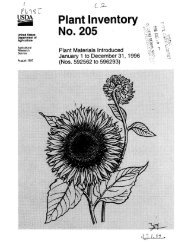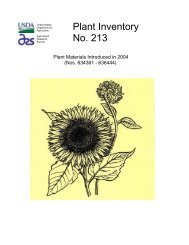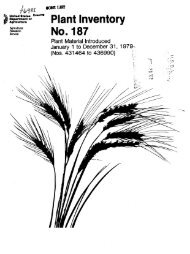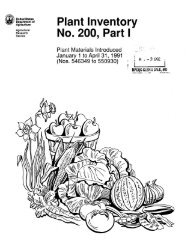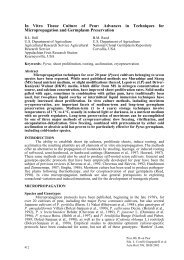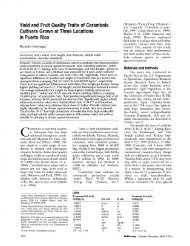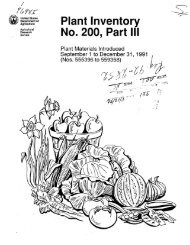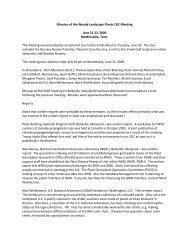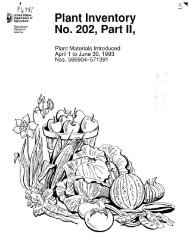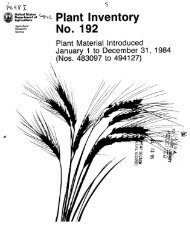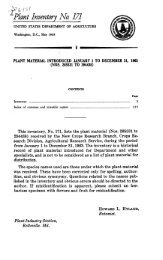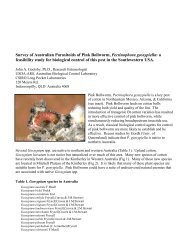- Page 1 and 2:
P(c ftfTIted Statespartment of^ricu
- Page 3 and 4:
Norris, R.A., ed. 1996. Plant Inven
- Page 5 and 6:
disease resistance genes may be obs
- Page 7 and 8:
Cultivated. NHA /25B; Ames 13474. A
- Page 9 and 10:
Cultivar. "KARY"; MIA 34824. Open p
- Page 11 and 12:
Cultivar. "La pischina"; MIA 34889.
- Page 13 and 14:
PI 576564. Musa acuminata CollaCult
- Page 15 and 16:
PI 576600. Arachis hypogaea L. var.
- Page 17:
Landrace. 1214; cacahuate criollo.
- Page 20 and 21:
Landrace. 773; 92ABWHSP-257; NSGC 1
- Page 22 and 23:
PI 576665. Triticum aestivum L., no
- Page 24:
on Izmir highway.The following were
- Page 28 and 29:
in Algeria. Elevation 870 m.PI 5767
- Page 30 and 31:
PI 576776. Triticum durum Desf.Land
- Page 32 and 33:
slope that flows into Ziyaret River
- Page 34 and 35:
Urfa, Turkey. Elevation 600 m. 3 km
- Page 36 and 37:
The following were collected by Ins
- Page 38 and 39:
The following were developed by M.
- Page 40 and 41:
The following were collected by J.
- Page 42 and 43:
PI 576913. Aliiurn lineare L.Wild.
- Page 44 and 45:
Wild. W6 4266. Collected in Former
- Page 46 and 47:
Glencoe, Illinois 60022, United Sta
- Page 48 and 49:
Plant Introduction Station, Pullman
- Page 50 and 51:
Cultivated. BJ-163; W6 1842. Collec
- Page 52 and 53:
The following were collected by D.
- Page 54 and 55:
PI 577027. Dactylis glomerata L.Cul
- Page 56 and 57:
PI 577063. Dactylis glomerata L.ABY
- Page 58 and 59:
Longitude 6 deg. 8 1E. Elevation 29
- Page 60 and 61:
PI 577125. Lactuca sativa L.Cultiva
- Page 62 and 63:
PI 577144. Lens culinaris MedikusCu
- Page 64 and 65:
PI 577172. Lens culinaris MedikusCu
- Page 66 and 67:
PI 577204. Lens culinaris MedikusCu
- Page 68 and 69:
PI 577236. Lens culinaris MedikusCu
- Page 70 and 71:
52 deg. 4 f N. Longitude 3 deg. 7'
- Page 72 and 73:
purple, blooming April to October.
- Page 74 and 75:
Wild. 2620a; W6 4728. Collected 197
- Page 76 and 77:
PI 577330. Medicago littoralis Rohd
- Page 78 and 79:
Wild. 771; W6 4604. Collected 1962
- Page 80 and 81:
ILCA 7542; W6 4213.PI 577376. Medic
- Page 82 and 83:
University of Alberta, Devonian Bot
- Page 84 and 85:
The following were collected by K.A
- Page 86 and 87:
PI 577454. Medicago prostrata Jacq.
- Page 88 and 89:
The following were donated by P. N.
- Page 90 and 91:
PI 577498. Medicago sativa L. sap.
- Page 92 and 93:
The following were donated by P. N.
- Page 94 and 95:
PI 577541. Medieago sativa ssp. cae
- Page 96 and 97:
PI 577564. Medicago sativa ssp. fal
- Page 98 and 99:
PI 577584. Medicago sativa var. vis
- Page 100 and 101:
PI 577607. Medieago truncatula Gaer
- Page 102 and 103:
Wild. 1105; W6 5967. Collected 1963
- Page 104 and 105:
The following were donated by P. N.
- Page 106 and 107:
The following were donated by Masar
- Page 108 and 109:
Cultivar. "ADVENTIST BEAN"; W6 9859
- Page 110 and 111:
PI 577714.Wild. WKT 27; 260785-40;
- Page 112 and 113:
University, Regional Plant Introduc
- Page 114 and 115:
PI 577756. Triticum aestivum L., no
- Page 116 and 117:
PI 577788. Triticum aestivum L., no
- Page 118 and 119:
The following were developed by Pur
- Page 120 and 121:
TOL 419; Tolima 419; NSL 286390.PI
- Page 122 and 123:
variable for fine culms. Separated
- Page 124 and 125:
Sinop, Turkey. Elevation 1000 m. 21
- Page 126 and 127:
Turkey. Elevation 1050 m. 24 km nor
- Page 128 and 129:
PI 577923. Avena sativa L.Cultivate
- Page 130 and 131:
PI 577946. Avena sativa L.Cultivate
- Page 132 and 133:
plants.PI 577970. Avena sativa L.Cu
- Page 134 and 135:
field. Separated from original bulk
- Page 136 and 137:
The following were developed by Tho
- Page 138 and 139:
Cultivar. "VANFALL". PVP 9400083.Th
- Page 140 and 141:
excellent baking quality.The follow
- Page 142 and 143:
The following were developed by Den
- Page 144 and 145:
The following were developed by Dav
- Page 146 and 147:
The following were donated by Rober
- Page 148 and 149:
PI 578090. Secale cereale L. asp. c
- Page 150 and 151:
Netherlands. Received 08/31/1992.PI
- Page 152 and 153:
yield. Improved plant height and fo
- Page 154 and 155:
PI 578137. Triticum aestivum L., no
- Page 156 and 157:
Elevation 905 m. Large scattered po
- Page 158 and 159:
Fluviopolis.100+ seed collected.The
- Page 160 and 161:
The following were collected by Wil
- Page 162 and 163:
The following were donated by G. Ei
- Page 164 and 165:
PI 578209. Triticum aestivum L., no
- Page 166 and 167:
The following were developed by Lou
- Page 168 and 169:
PI 578245. Avena nuda L.Breeding. 8
- Page 170 and 171:
PI 578254. Medicago sativa ssp. fal
- Page 172 and 173: 04/11/1994.PI 578263. Phaseolus vul
- Page 174 and 175: yielding ability with present comme
- Page 176 and 177: PI 578283. Cicer arietinum L.Cultiv
- Page 178 and 179: The following were developed by Uni
- Page 180 and 181: PI 578312. Glycine max (L.) Merr.Cu
- Page 182 and 183: Unknown source. Received 04/19/1994
- Page 184 and 185: eg/seed), black.The following were
- Page 186 and 187: Received 04/19/1994.PI 578336. Glyc
- Page 188 and 189: PI 578370. Glycine max (L.) Merr.Cu
- Page 190 and 191: Unknown source. Received 04/19/1994
- Page 192 and 193: Cultivar. "Gong jiao 6005-3"; 00144
- Page 194 and 195: The following were donated by Insti
- Page 196 and 197: purple. Flower color purple. Seed c
- Page 198 and 199: Landrace. Viet khai 4. Collected in
- Page 200 and 201: Unknown source. Received 04/19/1994
- Page 202 and 203: PI 578486. Glycine soja Siebold & Z
- Page 204 and 205: PI 578519. Agropyron cristatum (L.)
- Page 206 and 207: Cultivar. "MARTIN". CV-2. Pedigree
- Page 208 and 209: Crops Branch, Bag Service #47, Laco
- Page 210 and 211: Late-maturing hay-type. Blooms and
- Page 212 and 213: 18918-544. Collected in Portugal.PI
- Page 214 and 215: PI 578633. Dactylis glomerata L.188
- Page 216 and 217: PI 578667. Dactylis glomerata L.CRO
- Page 218 and 219: The following were donated by Color
- Page 220 and 221: PI 578695. Elytrigia intermedia (Ho
- Page 224 and 225: The following were donated by J. F.
- Page 226 and 227: underground root stocks than other
- Page 228 and 229: PI 578750. Leymus triticoides (Buck
- Page 230 and 231: Cultivar. "ACCLAIM". PVP 8000051.Th
- Page 232 and 233: PI 578783. Phalaris aquatica L.FALO
- Page 234 and 235: Agronomy Department, St. Paul, Minn
- Page 236 and 237: PI 578816. Poa hybridP-14977; W6 62
- Page 238 and 239: PI 578831. Poa pratensis L.Breeding
- Page 240 and 241: Box 217, Forest Grove, Oregon 97116
- Page 242 and 243: PI 578860. X Festuloliuxn ascendens
- Page 244 and 245: Laboratory, P.O. Box 5677, Fargo, N
- Page 246 and 247: PI 578892. Vigna unguiculata (L.) W
- Page 248 and 249: Cultivated. ATILANO; EAI 3760; Grif
- Page 250 and 251: Cultivated. UCR 3950; TVu 101; Grif
- Page 252 and 253: Cultivated. UCR 2801; TVu 146; Grif
- Page 254 and 255: Cultivated. UCR 2828; TVu 210; Grif
- Page 256 and 257: Cultivated. UCR 2857; TVu 277; Grif
- Page 258 and 259: Cultivated. UCR 2885; TVu 365; Grif
- Page 260 and 261: Cultivated. UCR 2913; TVu 419; Grif
- Page 262 and 263: Cultivated. UCR 2943; TVu 478; Grif
- Page 264 and 265: Cultivated. UCR 2974; TVu 517; Grif
- Page 266 and 267: Cultivated. UCR 3005; TVu 748; Grif
- Page 268 and 269: Cultivated. UCR 83; TVu 857; Grif 2
- Page 270 and 271: Cultivated. UCR 3067; TVu 988; Grif
- Page 272 and 273:
Cultivated. UCR 3097; TVu 1031; Gri
- Page 274 and 275:
Cultivated. UCR 3129; TVu 1077; Gri
- Page 276 and 277:
Cultivated. UCR 3159; TVu 1151; Gri
- Page 278 and 279:
Cultivated. UCR 3191; TVu 1198; Gri
- Page 280 and 281:
Cultivated. UCR 3222; TVu 1234; Gri
- Page 282 and 283:
Cultivated. UCR 3254; TVu 1274; Gri
- Page 284 and 285:
Cultivated. UCR 3391; TVu 1353; Gri
- Page 286 and 287:
Cultivated. UCR 4001; TVu 1431; Gri
- Page 288 and 289:
Cultivated. UCR 3407; TVu 1478; Gri
- Page 290 and 291:
Cultivated. UCR 4037; TVu 1539; Gri
- Page 292 and 293:
Cultivated. UCR 3445; TVu 1601; Gri
- Page 294 and 295:
Cultivated. UCR 4067; TVu 1658; Gri
- Page 296 and 297:
Cultivated. UCR 4080; TVu 1734; Gri
- Page 298 and 299:
Cultivated. UCR 4090; TVu 1803; Gri
- Page 300 and 301:
Cultivated. UCR 3532; TVu 1875; Gri
- Page 302 and 303:
Cultivated. UCR 4129; TVu 1941; Gri
- Page 304 and 305:
Cultivated. UCR 3563; TVu 1985; Gri
- Page 306 and 307:
Cultivated. UCR 3581; TVu 2071; Gri
- Page 308 and 309:
Cultivated. UCR 4169; TVu 2124; Gri
- Page 310 and 311:
Cultivated. UCR 4183; TVu 2356; Gri
- Page 312 and 313:
Cultivated. UCR 3641; TVu 2508; Gri
- Page 314 and 315:
Cultivated. UCR 4214; TVu 3638; Gri
- Page 316 and 317:
Cultivated. UCR 4257; TVu 4499; Gri
- Page 318 and 319:
Cultivated. UCR 4302; TVu 5139; Gri
- Page 320 and 321:
Cultivated. UCR 3700; TVu 5720; Gri
- Page 322 and 323:
Cultivated. UCR 3722; TVu 6339; Gri
- Page 324 and 325:
Cultivated. UCR 4419; TVu 6479; Gri
- Page 326 and 327:
Cultivated. UCR 3761; TVu 6601; Gri
- Page 328 and 329:
Species IndexAchnatherum hymenoides
- Page 330 and 331:
Eragrostis lehmanniana (578705)Erag
- Page 332:
Pseudoroegneria spicata (578855)Puc




